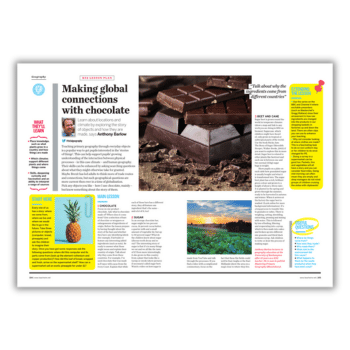Learn about locations and climate zones by exploring the story of objects and how people make them with this KS2 lesson plan themed around chocolate…
Teaching primary geography through everyday objects is a popular way to interest pupils in the ‘stories of things’.
This can help support pupils’ growing understanding of the interaction between physical processes – in this case climate – and human geography.
Enhance their skills by asking searching questions about what they might otherwise take for granted. Pick any objects you like. Here I use chocolate.
Climate zones KS2 learning objectiv
- Place knowledge, such as what plants grow in a country and how things are made
- Know which climates support different plants and where things come from
- Ability to interpret a range of sources
Starter activity
Ask what chocolate is made of. Where does it come from? Give a selection of bars of chocolate or wrappers or enlargements of ingredients of origin.
Before the lesson, prepare by thinking about the story of the bars and whether they have any identifying labels (for example, Fairtrade) or feature any interesting added ingredients (such as nuts).
Be ready to answer what these might mean and explain their country of origin. Talk about why they come from these countries.
For example, I’ve used chocolate that was made in France with cacao from the Ivory Coast. Explain that while each of these bars has a different story, they all feature one ingredient that’s the same – and a lot of it, too!
Anthony Barlow lectures in geography education at the University of Roehampton after 12 years as a KS2 teacher. He is the author of Mastering Primary Geography (Bloomsbury). Follow him on X at @totalgeography.














